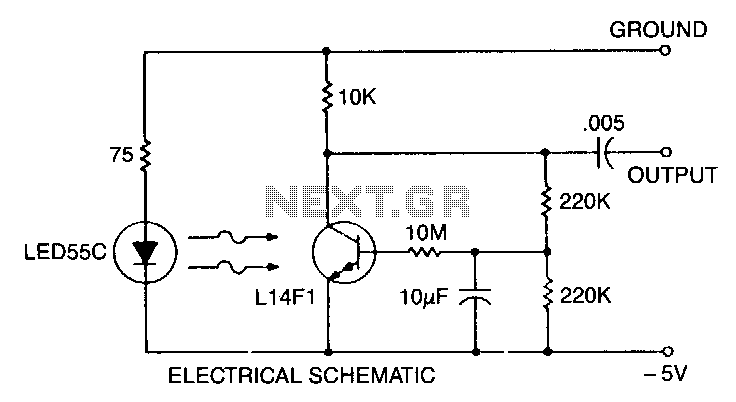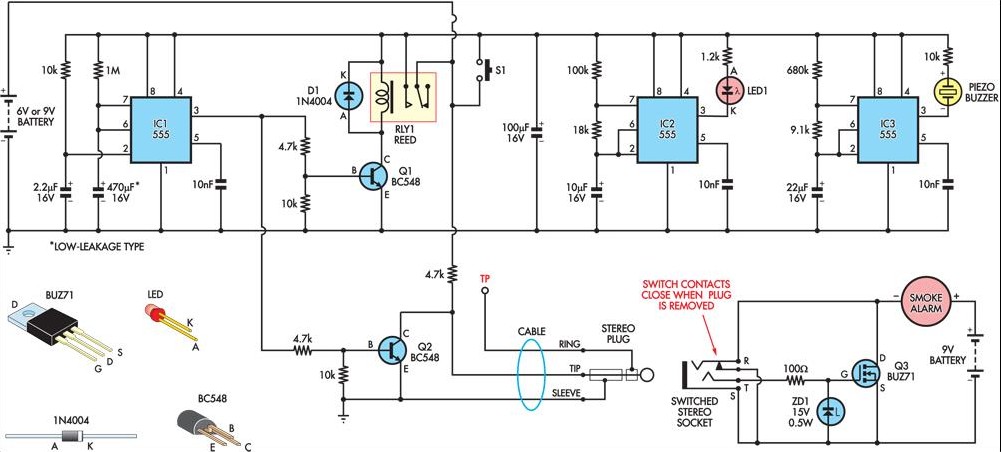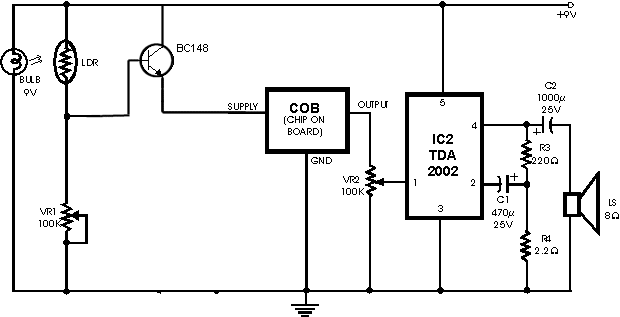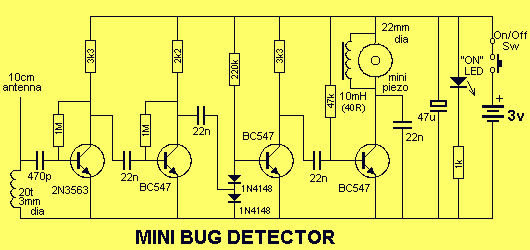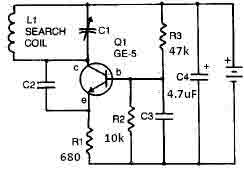
GPZ spike Detector
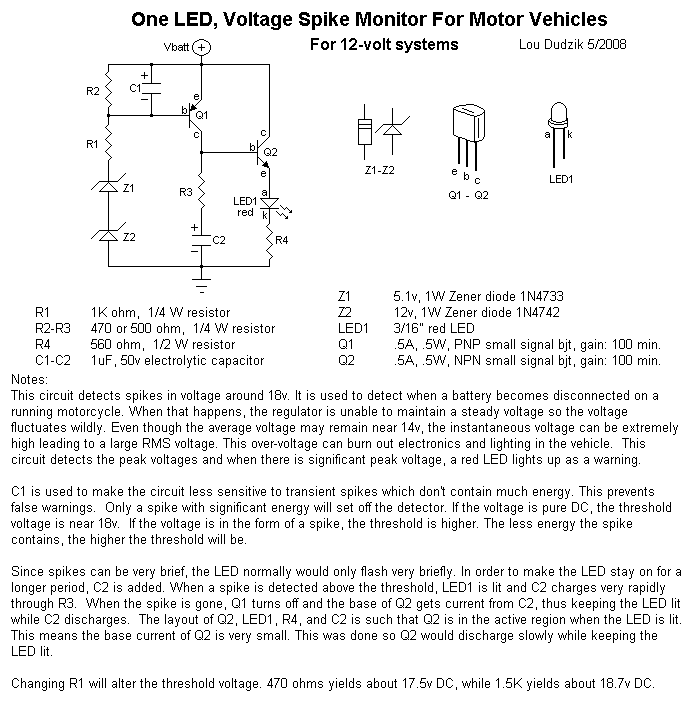
This circuit detects voltage spikes around 18V and is designed to identify when a battery becomes disconnected on a running motorcycle. When this disconnection occurs, the voltage regulator cannot maintain a steady output, resulting in significant voltage fluctuations. Although the average voltage may hover around 14V, the instantaneous voltage can reach very high levels, leading to a large RMS voltage. Such over-voltage conditions can damage electronics and lighting within the vehicle. The circuit monitors peak voltages, and when a significant spike occurs, a red LED illuminates as a warning. Capacitor C1 is incorporated to reduce sensitivity to transient spikes that lack substantial energy, thereby preventing false alarms. Only spikes with considerable energy will trigger the detector. For pure DC voltage, the threshold is approximately 18V, while the threshold for spikes is higher; the less energy a spike contains, the higher the threshold becomes. Due to the brief nature of spikes, the LED would typically only flash momentarily. To prolong the LED illumination, capacitor C2 is introduced. Upon detecting a spike above the threshold, LED1 lights up, and C2 charges rapidly through resistor R3. Once the spike subsides, transistor Q1 turns off, allowing the base of transistor Q2 to receive current from C2, which keeps the LED illuminated during C2's discharge. The arrangement of Q2, LED1, R4, and C2 ensures that Q2 remains in the active region while the LED is lit, resulting in minimal base current for Q2, which allows for a slow discharge while keeping the LED on.
This circuit employs a voltage detection mechanism that is crucial for motorcycle safety, especially in scenarios where battery disconnection could lead to erratic voltage levels. The use of C1 serves as a filter, effectively mitigating the effect of minor transient spikes that could otherwise trigger unnecessary alerts. This design choice enhances the reliability of the system by ensuring that only significant voltage spikes are detected, thus reducing the likelihood of false positives.
The choice of components is critical in achieving the desired response time and sensitivity. Capacitor C2 plays a vital role in ensuring that the LED remains lit for a longer duration after a spike has been detected, allowing the rider to notice the warning clearly. The rapid charging of C2 through R3 ensures a quick response to voltage spikes, while the careful arrangement of Q2 and the associated resistors allows for controlled discharge, ensuring that the LED remains illuminated without excessive power draw.
In summary, this circuit provides a robust solution for monitoring voltage fluctuations in motorcycle applications, effectively alerting the user to potentially damaging conditions while minimizing false alarms through careful component selection and circuit design. The integration of transistors and capacitors allows for a sophisticated approach to voltage spike detection, making it a valuable addition to any motorcycle's electronic system.This circuit detects spikes in voltage around 18v. It is used to detect when a battery becomes disconnected on a running motorcycle. When that happens, the regulator is unable to maintain a steady voltage so the voltage fluctuates wildly. Even though the average voltage may remain near 14v, the instantaneous voltage can be extremely high leading t
o a large RMS voltage. This over-voltage can burn out electronics and lighting in the vehicle. This circuit detects the peak voltages and when there is significant peak voltage, a red LED lights up as a warning. C1 is used to make the circuit less sensitive to transient spikes which don`t contain much energy. This prevents false warnings. Only a spike with significant energy will set off the detector. If the voltage is pure DC, the threshold voltage is near 18v. If the voltage is in the form of a spike, the threshold is higher. The less energy the spike contains, the higher the threshold will be. Since spikes can be very brief, the LED normally would only flash very briefly. In order to make the LED stay on for a longer period, C2 is added. When a spike is detected above the threshold, LED1 is lit and C2 charges very rapidly through R3. When the spike is gone, Q1 turns off and the base of Q2 gets current from C2, thus keeping the LED lit while C2 discharges.
The layout of Q2, LED1, R4, and C2 is such that Q2 is in the active region when the LED is lit. This means the base current of Q2 is very small. This was done so Q2 would discharge slowly while keeping the LED lit. 🔗 External reference
This circuit employs a voltage detection mechanism that is crucial for motorcycle safety, especially in scenarios where battery disconnection could lead to erratic voltage levels. The use of C1 serves as a filter, effectively mitigating the effect of minor transient spikes that could otherwise trigger unnecessary alerts. This design choice enhances the reliability of the system by ensuring that only significant voltage spikes are detected, thus reducing the likelihood of false positives.
The choice of components is critical in achieving the desired response time and sensitivity. Capacitor C2 plays a vital role in ensuring that the LED remains lit for a longer duration after a spike has been detected, allowing the rider to notice the warning clearly. The rapid charging of C2 through R3 ensures a quick response to voltage spikes, while the careful arrangement of Q2 and the associated resistors allows for controlled discharge, ensuring that the LED remains illuminated without excessive power draw.
In summary, this circuit provides a robust solution for monitoring voltage fluctuations in motorcycle applications, effectively alerting the user to potentially damaging conditions while minimizing false alarms through careful component selection and circuit design. The integration of transistors and capacitors allows for a sophisticated approach to voltage spike detection, making it a valuable addition to any motorcycle's electronic system.This circuit detects spikes in voltage around 18v. It is used to detect when a battery becomes disconnected on a running motorcycle. When that happens, the regulator is unable to maintain a steady voltage so the voltage fluctuates wildly. Even though the average voltage may remain near 14v, the instantaneous voltage can be extremely high leading t
o a large RMS voltage. This over-voltage can burn out electronics and lighting in the vehicle. This circuit detects the peak voltages and when there is significant peak voltage, a red LED lights up as a warning. C1 is used to make the circuit less sensitive to transient spikes which don`t contain much energy. This prevents false warnings. Only a spike with significant energy will set off the detector. If the voltage is pure DC, the threshold voltage is near 18v. If the voltage is in the form of a spike, the threshold is higher. The less energy the spike contains, the higher the threshold will be. Since spikes can be very brief, the LED normally would only flash very briefly. In order to make the LED stay on for a longer period, C2 is added. When a spike is detected above the threshold, LED1 is lit and C2 charges very rapidly through R3. When the spike is gone, Q1 turns off and the base of Q2 gets current from C2, thus keeping the LED lit while C2 discharges.
The layout of Q2, LED1, R4, and C2 is such that Q2 is in the active region when the LED is lit. This means the base current of Q2 is very small. This was done so Q2 would discharge slowly while keeping the LED lit. 🔗 External reference
